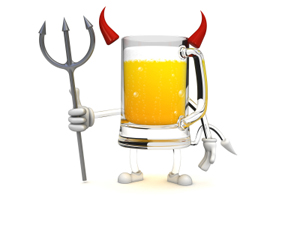Off-flavours in beer
Here are some informations to help you identifying unwanted flavours in beers and the causes for those off-flavours.Source: http://www.carolinabrewmasters.com/PDF/Complete_Beer_Fault_Guide.pdf

| what | described as | origin | comment |
| acetaldehyde | green apple, cidery, latex paint | yeast activity, microbial contamination | increased by underpitching; fermentation too cool or incomplete; insufficient conditioning; bacterial infection (if accompanied by sulfur or acetic acid) more present in young beer; might increase with oxidation |
| acetic sourness | tart, vinegary | microbial contamination | increased by inoculation with bacteria or wild yeast; exposing green or packaged beer to air high levels are caused by oxidation of ethanol by bacteria |
| autolyzed | meaty, soy sauce, burned rubber, dirty diaper | yeast, aging | occurs when yeast cells die |
| butyric acid | rancid butter, baby vomit, cheese | microbes in the cellar or storage vessels | never an asset |
| cidery | green apple, apple | yeast, adjunct sugars | beer made with a high proportion (20% or more) of sugar often has a cidery flavor and aroma. Can also be due to weak or incomplete fermentation (see "acetaldehyde") |
| chlorophenol | band-aid, plastic, medicinal | process/equipment faults; contamination | |
| diacetyl (Vicinal Diketones (VDK)) | butter, popcorn, butterscotch, honey, milky | yeast; microbial contamination | natural byproducts of fermentation which should be reabsorbed by the yeast in final phases. Low levels ate acceptable in Bohemian Pilsner, English Pale and Brown Ales, some Porters and Stouts. |
| DMS (dimethyl sulfide) | cooked vegetable, celery, cabbage, corn, sulfury | malt, microbial contamination | darker malts have less DMS than paler malts. Since DMS is produced at temperatures below boiling, slow cooling of the wort means that DMS is formed which isn't boiled away. Wild yeast may produce high DMS levels but also produce other off-flavors (acetic acid, phenols, sulfur). |
| fusel alcohols | burning, alcoholic, harsh | yeast | avoid with proper fermentation temperature and/or proper yeast health |
| gushing | explosive release of carbonation at the opening of the bottle; splash and overflow | sugar; bacteria | too much sugar used for the second fermentation in bottle or development of a mushroom from the malt; can also be caused by a high temperature change |
| lactic sourness | citric, lactic, tart, yogurt | microbial contamination | caused by infection of bacteria - most commonly Lactobacillus. Medium to high levels are expected in Berliner Weisse and in sour ales. |
| lightstruck/skunky | aroma of gaz (thiol), catty, fecal, mercaptan, skunky, sulfury | mishandling | decomposition of the isohumulones (compounds of hops) by the light of sun or neons; this is the reason why bottles should be brown and not clear or green to better protect the beer against this action |
| metallic | blood-like, coppery, iron | contamination | caused by unprotected metals dissolving into the wort or pasteurization problems; to avoid: properly treat water to remove excessive metallic ions; don't use equipment likely to corrode |
| mineral | chalky, dusty, sulfate, eggs | water | properly treat brewing water; don't use excessive amounts of brewing salts |
| oxidation / maderisation | almond, leathery, papery, cardboard, musty | aging, process faults | due to wort exposed to oxygen at temperatures above 26 C; can also appear when the beer gets too old or the lagering temperature is too high |